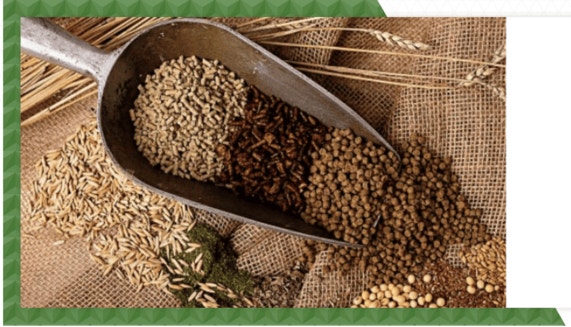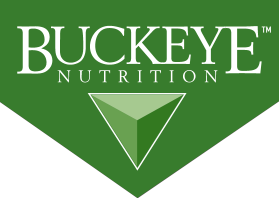Categories of Equine Feeds

CONCENTRATES, RATION BALANCERS, AND COMPLETE FEEDS EXPLAINED.
Feeding horses has become increasingly complex over time as research advances our understanding of equine nutrition and innovation improves feed production. Today’s equine feed industry offers a variety of commercial options to meet horses' diverse nutritional needs, but this can make choosing the right product challenging for owners and equine managers. With so many options available, it’s essential for horse owners to understand the purpose and proper use of each feed type or category to keep their horses healthy, energized, and performing at their best.
In this article, we’ll explore the three main types of commercial horse feeds: feed concentrates, ration balancers, and complete feeds. We’ll also highlight the importance of feeding rates, how to assess work level, and what makes up the foundation of every high-quality feed program.
The Importance of Minimum Feeding Rates
Before exploring feed types, it’s important to understand a key principle: meeting your horse’s minimum daily feed rate is essential for a balanced diet. All commercial feed products are legally required to include feeding instructions that specify the amount to feed based on your horse’s weight and workload. These guidelines should be found on the product's feed tag or printed directly on the bag. Meeting your horses' daily minimum feed rate is the only way to ensure they receive adequate levels of protein, vitamins, and minerals.
Feeding less than the recommended amount, regardless of the type of feed, can lead to nutritional deficiencies. This is particularly true for horses in moderate to intense work, growing horses, pregnant or lactating mares, or horses recovering from illness or injury. These animals need higher levels of essential nutrients, especially amino acids like lysine, methionine, and threonine—the building blocks of protein.
Weighing your feed is the only way to ensure your horse receives enough feed to meet their daily minimum feed rate requirement. Using the number of “scoops” to gauge feed volume isn’t ideal, as scoop sizes often vary from barn to barn; some horse owners use an old coffee can, while others use a standard kitchen measuring cup. Feed density also differs greatly between pellets, textured, and extruded feeds, making it essential to weigh each feed type separately. A basic kitchen scale can provide accurate measurements and peace of mind!
Feed Concentrates: A Versatile Source of Energy
What Are Feed Concentrates?
Feed concentrates are likely the most familiar feed type to horse owners. They are designed to be fed alongside forage (hay or pasture), provide a balanced vitamin and mineral profile, and supply additional calories to the diet. These feeds support horses with higher energy needs or those who can’t maintain a healthy body weight on forage alone, and are a great option for hard keepers and some performance horses.
Feed concentrates come in several forms:
- Textured (cereal grains mixed with pellets, can be high in molasses content)
- Pelleted (ingredients are ground, treated with steam, and compressed into pellets)
- Extruded (ingredients are ground and pressure-cooked, leading to a puffed appearance and increased digestibility)
When Are Concentrates Used?
- Performance horses needing additional energy or weight
- Horses who can't maintain weight on forage alone
- Horses with increased nutrient and energy demands due to work, growth, or lactation
Nutritional Overview
- Protein: Usually ranges from 10% to 14%
- Fat: Varies from 3% to over 10%, depending on the formula
- Fiber and NSC (starch + sugar): Highly variable
- Low NSC options exist for metabolic horses!
- Feeding rate: Typically 4–10+ lbs per day, depending on weight and work level
When assessing feed concentrates, look for lysine on the guaranteed analysis—values close to 1% are indicative of high-quality protein sources that can provide effective muscle support!
Ration Balancers: The Equine Multivitamin
What Are Ration Balancers?
Ration balancers are highly fortified, low-calorie products enriched with vitamins, minerals, and amino acids. They are fed in small quantities, usually between 1–3 lbs per day. Balancers are ideal for easy keepers (horses that maintain weight on a primarily forage-based diet) because they help fill nutritional gaps that forage alone can't reach, while not adding excess fat and calories to the diet.
Ideal For:
- Easy keepers
- Horses on forage-only diets
- Horses receiving less than the recommended minimum of another feed
Nutritional Overview
- Protein: Typically between 12% and 32%
- Fat: 4%–8%
- Fiber: 5%–20%
- NSC: 8%–16% depending on the product
Some balancers are designed to complement certain protein-rich forage types, like alfalfa and other legumes. Because these forage types have high protein levels, forage-specific balancers will have a lower protein content to avoid oversupplying protein in the diet. For the average, healthy equine, excess dietary protein is excreted very efficiently through urine. Using alternative protein sources may also result in lower protein levels when compared to ration balancers that use soy as their protein source.
A common misconception about ration balancers is that high-protein feeds make horses “hot” or more excitable, but this is not accurate. Horses rely on sugars, fiber, and fats for energy well before they convert protein into fuel. Usually, the true cause of excitable behavior is excess starch, sugar, or calories in the diet. When horses are on a nutritionally deficient diet, they might indeed become more excitable as they begin receiving more robust nutrition. During these periods, they are likely feeling particularly good as they start to receive adequate levels of amino acids, vitamins, and minerals. This increase in energy is not tied to the protein value of their feed or forage.
Complete Feeds: Forage Replacement Solutions
What Are Complete Feeds?
Complete feeds are designed to replace all or most of the forage in a horse’s diet. They are typically used for horses that have trouble chewing hay because of dental problems but may also be used when hay is in short supply. These feeds are high in fiber and are intended to be the sole source of nutrition in the diet, and due to this, will often have feeding rates upwards of 12 pounds daily to supply enough fiber to keep the horse's gut functioning adequately. Complete feeds can be fed alongside forage, and certain medical situations may warrant this, but most often, a feed concentrate or ration balancer is going to be the best match for horses who can chew forage adequately. Complete feeds are usually available in pelleted or extruded form. They can often be soaked into a mash, making them ideal for horses with dental problems or those recovering from choke or colic.
Ideal For:
- Horses with dental issues who cannot adequately chew hay
- Horses in recovery from choke or colic
- Horses with no access to hay or pasture
Nutritional Overview
- Protein: Typically 12%–14%
- Fiber: 15% or higher
- Fat and NSC: Vary depending on the product
Feeding Rate:
- With forage: 6+ lbs/day
- As forage replacement: upwards of 10+ lbs daily
Matching Feed to Your Horse’s Workload
Workload greatly influences a horse’s nutritional requirements. The National Research Council (NRC) defines work levels as follows:
Light Work: exercised 1–3 hrs/week, mostly walking and trotting
Moderate Work: exercised 3–5 hrs/week, primarily trotting
Heavy Work: exercised 4–5 hrs/week, trotting and cantering
Very Heavy/Intense Work: exercised 6–12 hrs/week with high-speed work (e.g., racehorses, eventers, polo ponies)
As workload increases, so do the needs for protein, amino acids, electrolytes (like sodium, potassium, and chloride), and energy. Feeding rate recommendations provided on your feed bag will indicate an appropriate feeding rate for your horse based on their body weight and workload.
Building a Solid Foundation
While we have discussed many aspects of feed above, it is crucial to remember that a quality forage (hay or pasture) should be the foundation of every equine diet. Even the highest quality feeds can’t always compensate for forage that is lacking in intake and quality. Feed concentrates or ration balancers should be used in conjunction with high-quality forage, fed in appropriate amounts, to achieve optimal condition and performance. Horses should consume at least 1.5% of their body weight daily as forage; for the average-sized 1000lb horse, this equates to a minimum of 15 pounds of forage daily. Forage is what our horses are designed to digest, and maximizing their forage intake has numerous proven benefits for both physical and mental health, as well as behavioral health. No matter what category or type of feed product you choose, meeting your horses' daily forage needs by weight is an essential step to ensuring your horse’s diet supports their health and well-being.
Choosing the Right Feed
Understanding the differences between feed concentrates, ration balancers, and complete feeds is crucial for providing a balanced diet. To quickly recap:
- Feed concentrates are best suited for horses that require extra energy and nutrients to maintain appropriate condition.
- Ration balancers are ideal for horses that maintain weight easily on forage and only need their essential amino acids, vitamins, and minerals supplemented.
Complete feeds are designed for horses that can’t chew hay or those that require complete forage replacement.
Nutrition can be challenging to manage. There are countless options and even more opinions about what’s best for our horses. We’re always here to help, whether you have general feeding questions or need assistance developing customized programs tailored to your horse or management situation. Our nutrition advisors are ready and waiting to answer your questions, no matter how large or small. Visit our Contact Us page to get connected!
